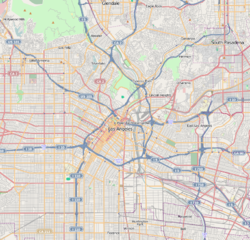Country Club Park, Los Angeles
Country Club Park | |
|---|---|
 Country Club Park signage located at Crenshaw Boulevard immediately north of Pico Boulevard | |
| Coordinates: 34°03′04″N 118°19′19″W / 34.0511512°N 118.3218523°W | |
| Country | |
| State | |
| County | |
| Time zone | Pacific |
| Zip Code | 90019 |
| Area code | 323 |
Country Club Park is a neighborhood in Los Angeles, California.
Geography
Country Club Park is bounded by Olympic Boulevard on the north, Crenshaw Boulevard on the west, Pico Boulevard on the south, and Western Avenue on the east. [1][2] It is located within the larger Arlington Heights district.
History
The name Country Club Park refers to the area's previous use. In 1897, The Los Angeles Golf Club established a 9-hole course called the Windmill Links at Pico and Alvarado Street. Overcrowding inspired the organizers to move west and in 1899, the club moved to the corner of Pico and Western (the area that is now Country Club Park). The course remained there until 1910, at which time it moved to Holmby Hills. [3]
After The Los Angeles Golf Club moved west, Isaac Milbank, with partner George Chase, subdivided the property for mostly large homes and mansions. Country Club Park matured in the 1920s and homes were constructed in the latest architectural styles: Craftsman, Tudor Revival, Spanish Colonial Revival, Colonial Revival and Mediterranean Revival.
In 2010, the neighborhood was designated a Los Angeles Historic Preservation Overlay Zone because of the large number of intact buildings dating back to the earliest phases of Los Angeles’ development.[1]

